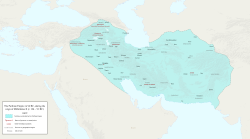পার্থিয়ান সাম্রাজ্য
পার্থিয়ান সাম্রাজ্য, আর্সাসিদ সাম্রাজ্য নামেও পরিচিত,[১১] খ্রিস্টপূর্ব ২৪৭ খ্রিস্টাব্দ থেকে ২২৪ খ্রিস্টাব্দ পর্যন্ত প্রাচীন ইরানের একটি প্রধান ইরানি রাজনৈতিক ও সাংস্কৃতিক শক্তি ছিল।[১২] সাম্রাজ্যের দ্বিতীয় নামটি প্রতিষ্ঠাতা প্রথম আর্সেসাসের নাম থেকে এসেছিল।[১৩] প্রথম আর্সেসাস ইরানের উত্তর-পূর্বে পার্থিয়া[১৪] অঞ্চল ও তারপর আন্দ্রাগোরাসের অধীনে একটি সত্রপ (প্রদেশ) জয় করার জন্য পার্নি উপজাতির নেতৃত্ব দিয়েছিলেন, এবং সেলেউকিদোন সাম্রাজ্যের বিরুদ্ধে বিদ্রোহ করেছিলেন। প্রথম মিথ্রিদেটস (১৭১-১৩২ খ্রিস্টপূর্বাব্দ) সেলেউকিদদের কাছ থেকে মাদ ও মেসোপটেমিয়া দখল করে সাম্রাজ্যের ব্যাপক প্রসার ঘটান। শীর্ষ সময়ে, পার্থিয়ান সাম্রাজ্য ইউফ্রেটিসের উত্তর প্রান্ত পর্যন্ত বিস্তৃত ছিল, যা এখন মধ্য-পূর্ব তুরস্ক থেকে বর্তমান আফগানিস্তান ও পশ্চিম পাকিস্তান পর্যন্ত বিস্তৃত এক বিস্তীর্ণ এলাকা। ভূমধ্যসাগরীয় অববাহিকায় রোমান সাম্রাজ্য ও চীনের হান রাজবংশের মধ্যে রেশম বাণিজ্য পথে অবস্থিত সাম্রাজ্যটি ব্যবসা-বাণিজ্যের কেন্দ্রে পরিণত হয়েছিল।
পার্থিয়ান সাম্রাজ্য | |||||||||
|---|---|---|---|---|---|---|---|---|---|
| ২৪৭ খ্রিস্টপূর্বাব্দ–২২৪ খ্রিস্টাব্দ | |||||||||
 The Parthian Empire in 94 BC at its greatest extent, during the reign of Mithridates II (শা. 124–91 BC) | |||||||||
| রাজধানী | Ctesiphon,[১] Ecbatana, Hecatompylos, Susa, Mithradatkirt, Asaak, Rhages | ||||||||
| প্রচলিত ভাষা |
| ||||||||
| ধর্ম | |||||||||
| সরকার | Feudal রাজতন্ত্র[৮] | ||||||||
| Monarch | |||||||||
• 247–211 BC | Arsaces I (first) | ||||||||
• 208–224 AD | Artabanus IV (last) | ||||||||
| আইন-সভা | Megisthanes | ||||||||
| ঐতিহাসিক যুগ | ধ্রুপদী সভ্যতা | ||||||||
• প্রতিষ্ঠা | ২৪৭ খ্রিস্টপূর্বাব্দ | ||||||||
• বিলুপ্ত | ২২৪ খ্রিস্টাব্দ | ||||||||
| আয়তন | |||||||||
| 1 AD[৯][১০] | ২৮,০০,০০০ বর্গকিলোমিটার (১১,০০,০০০ বর্গমাইল) | ||||||||
| মুদ্রা | দ্রাকমা | ||||||||
| |||||||||
পার্থিয়ানরা তাদের থেকে সাংস্কৃতিকভাবে ভিন্নধর্মী পারস্য, হেলেনীয় ও আঞ্চলিক সাম্রাজ্যের শিল্প, স্থাপত্য, ধর্মীয় বিশ্বাস ও রাজকীয় চিহ্নগুলিকে গ্রহণ করেছিল। তার অস্তিত্বের প্রায় প্রথমার্ধে, আর্সসিদ আদালত গ্রিসের সংস্কৃতির উপাদানগুলি গ্রহণ করেছিল, যদিও এটি শেষ পর্যন্ত ইরানীয় ঐতিহ্যের ক্রমশ পুনরুজ্জীবন দেখেছিল।
তথ্যসূত্র
সম্পাদনা- ↑ Fattah, Hala Mundhir (২০০৯)। A Brief History of Iraq। Infobase Publishing। পৃষ্ঠা 46। আইএসবিএন 978-0-8160-5767-2।
One characteristic of the Parthians that the kings themselves maintained was their nomadic urge. The kings built or occupied numerous cities as their capitals, the most important being Ctesiphon on the Tigris River, which they built from the ancient town of Opis.
- ↑ Skjærvø 2004, পৃ. 348–366।
- ↑ Canepa 2018, পৃ. 6।
- ↑ ক খ Green 1992, পৃ. 45
- ↑ Chyet, Michael L. (১৯৯৭)। Afsaruddin, Asma; Krotkoff, Georg; Zahniser, A. H. Mathias, সম্পাদকগণ। Humanism, Culture, and Language in the Near East: Studies in Honor of Georg Krotkoff। Eisenbrauns। পৃষ্ঠা 284। আইএসবিএন 978-1-57506-020-0।
In the Middle Persian period (Parthian and Sasanian Empires), Aramaic was the medium of everyday writing, and it provided scripts for writing Middle Persian, Parthian, Sogdian, and Khwarezmian.
- ↑ De Jong 2008, পৃ. 24, "It is impossible to doubt that the Parthians were Zoroastrians. The evidence from the Nisa ostraca and the Parthian parchment from Avroman suffice to prove this, by the use of the Zoroastrian calendar, which was restricted in use, as it had been previously, to communication with Iranians only, yielding to the Seleucid calendar whenever the Parthians dealt with non-Zoroastrians. There are indications, however, that the practice of Zoroastrianism had reserved a large place for the cult of divine images, either those of ancestors in the Fravashi cult, or of deities, and for the existence of sanctuaries dedicated to named deities other than Ahura Mazda, and including deities that are of a non-Avestan background. The Parthian god Sasan is a case in point, but better evidence comes from Armenia, where alongside Aramazd and Anahit, Mher and Vahagn, the West Semitic god Barshamin, and Babylonian Nane were worshipped, as well as the Anatolian Tork and the goddess Astghik of disputed origins."
- ↑ Brosius 2006, পৃ. 125, "The Parthians and the peoples of the Parthian empire were polytheistic. Each ethnic group, each city, and each land or kingdom was able to adhere to its own gods, their respective cults and religious rituals. In Babylon the city-god Marduk continued to be the main deity alongside the goddesses Ishtar and Nanai, while Hatra's main god, the sun-god Shamash, was revered alongside a multiplicity of other gods."
- ↑ Sheldon 2010, পৃ. 231
- ↑ Turchin, Peter; Adams, Jonathan M.; Hall, Thomas D (ডিসেম্বর ২০০৬)। "East-West Orientation of Historical Empires"। Journal of World-Systems Research। 12 (2): 223। আইএসএসএন 1076-156X। ১৭ সেপ্টেম্বর ২০১৬ তারিখে মূল থেকে আর্কাইভ করা। সংগ্রহের তারিখ ১৬ সেপ্টেম্বর ২০১৬।
- ↑ Taagepera, Rein (১৯৭৯)। "Size and Duration of Empires: Growth-Decline Curves, 600 B.C. to 600 A.D."। Social Science History। 3 (3/4): 121। জেস্টোর 1170959। ডিওআই:10.2307/1170959।
- ↑ From Greek Ἀρσάκης Arsakēs, from Parthian 𐭀𐭓𐭔𐭊 Aršak.
- ↑ Waters 1974, পৃ. 424.
- ↑ Brosius 2006, পৃ. 84
- ↑ "roughly western Khurasan" Bickerman 1983, পৃ. 6.